Questions
- Explain how you would make a diffraction grating on a piece of glass slide.
- One range of frequencies used in broadcasting varies from 0.5 x 100 Hz to 2.0 x 107 Hz. What is the longest wavelength of this range? Velocity of light air =3x108 m/s
- State one effect that would be observed when water waves pass from deep to shallow water.
- The figure below shows a wave profile. Determine the frequency of the wave.
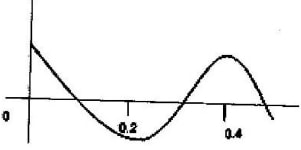
- What happens to the wavelength of a water wave when it moves from the deep part to the shallow part of a ripple tank?
- A source generates 40 waves in a second. If the wavelength is 8.5m.
Calculate the time taken to reach a wall 102m from the source. - What condition is necessary for a wave incident on a slit to be diffracted?
-
- Sketch a displacement-time graph of a wave of amplitude 0.5 cm and frequency 4Hz over a time interval of 1.25s
-
- State one condition not involving a phase difference for interference pattern to be observed.
- Two points sources s1 s2 oscillate in phase producing waves of wavelength = 1cm. The separation of the sources is 3cm
- Draw to scale a series of 10 semicircular lines to represent the wave fronts produced at intervals of one periodic time (T) for each of the two sources.
- Draw on the same diagram, lines which represent positions of constructive interference.
- Mark a point P on one of the lines drawn in II. Determine the magnitude of (S2P – S1P) in terms of wavelength.
- Light travels through glass of refractive index 1.5 with a speed v.
Calculate the value of v. (Speed of light in air =3.0 x 108 m/s). - Name a property of light that shows it is a transverse wave.
- In an experiment using a ripple tank the frequency, f of the electric pulse generator was reduced to one third of its original value. How does the new wave length compare with the initial wavelength? Explain your answer.
-
- Distinguish between stationary and progressive waves.
-
- Describe how a young’s double slit may be made in a laboratory.
- State the condition for a minimum to occur in an interference pattern.
- The sketch graph below shows the results of an experiment to study diffraction patterns using double silt.
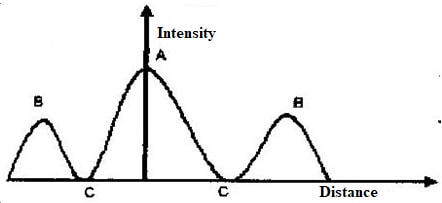
- Sketch an experimental set up that may be used to obtain such a pattern.
- Name an instrument for measuring intensity
- Explain how the peaks labelled A and B and troughs labeled C are formed.
- What measurable quantity is associated with colours of light?
- Circular water waves generated by a point source at the centre O of the pond are observed to have the pattern shown in the figure below. Explain the pattern.
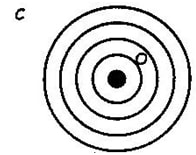
- Explain how a piece of Polaroid reduces the sun’s glare.
- In an experiment to observe interference of light waves, a double slit is place close to the source.
- State the function of the double silt.
- Describe what is observed on the screen.
- State what is observed on the screen when
- The slit separation S1S2 is reduced.
- White light is used instead of monochromatic source.
- The figure below shows an experimental arrangement. S1 and S2 are narrow slits.
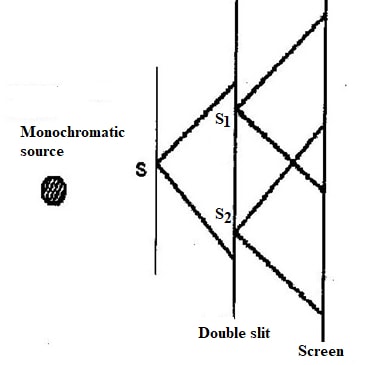
State what is observed on the screen when the source is:-- Monochromatic
- White light
-
-
- Distinguish between transverse and longitudinal waves.
- Give one example of a transverse wave and one example of a longitudinal wave.
- The figure below shows the displacement of a practice in progressive wave incident on a boundary between deep and shallow regions.
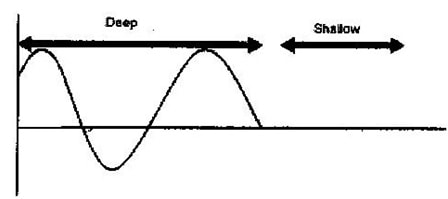
- Complete the diagram to show what is observed after boundary. (Assume no loss of energy).
- Explain the observation in (i) above.
-
- State one difference between mechanical and electromagnetic waves.
- The figure below shows the displacement-time graph for a certain wave.

Determine the frequency of the wave. (3mks) - Figures (a) and (b) below show wave fronts incident on barriers blocking part of the path.

On the same figures sketch the wave fronts to show the behaviour of the waves as they pass each barrier and after passing the barrier. (1mk) - A source generates 40 waves per second. If the wavelength is 8.5cm. Calculate the time waves takes to reach a wall 120 meters from the source.
- A gun is fired and an echo heard at the same place 0.5 s later. How far is the barrier which reflected the sound from the gun? (Velocity of sound = 340 m/s)
- A man standing between two parallel walls fires a gun. He hears an echo after 1.5 seconds and another one after 2.5 seconds and yet another one after 4 seconds. Determine the separation of the walls. (Take velocity of sound 340 m/s)
Answers
- Make the glass sooty. Make very small markings with the edge of a razor blade. The marking (slits) run parallel, to each other light passes through the slit as the rest of the glass has been blacken.
- The longer the wavelength the lower the frequency.
Wavelength = C = 3 x 108 = 600m
0.5 x 106 - Speed and wavelength decrease
- T = 0.45
F= 1/T = 1/0.4 = 2.5 Hz - The wave length decrease
- f = 40.λ = 8.5m
V= f λ = 40 x 8.5
= 340m/s
T= d/V = 102/340 = 0.3s - The slit and the wavelength of the wave have to be of the same order.
-
- T=1/f = 1/4 = 0.25s
So no. of waves S= t/T
= 1.25 = 5 wavelengths -
- Same wavelength & same frequency
- S2P – S1P = 9λ - 7 λ
- T=1/f = 1/4 = 0.25s
- n= V air
V medium
V= 3 x 108 = 2 x 108m/s
1.5 - Light can be plane polarized
- C= f λ
F = c/λ where c is constant so f is inversely proportional to λ. If f decreases by ¼ then value of λ is tripled -
- Stationary waves has nodes and antinodes but progressive wave does not have them
-
- By using a pin to rule two parallel lines about a third of a millimeter apart on a piece of thin glass coated with graphite and allowed to dry.
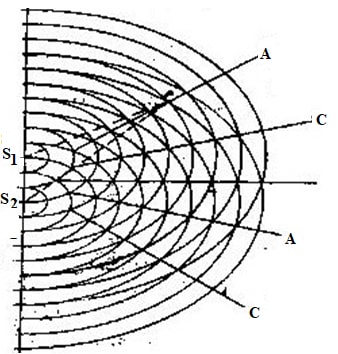
- Path difference = (n+ ½), where n= 0, 1, 2, 3, 4…….
- By using a pin to rule two parallel lines about a third of a millimeter apart on a piece of thin glass coated with graphite and allowed to dry.
-
-

- Light meters
- A is formed when path difference of the waves is zero so there is constructive interference. B is also due to constructive interference, but path differences is equal to one wavelength, C is as a result of destructive interference due to path differences being equal to half of one wavelength.
-
- Wavelength
- Tank becoming shallower outwards from the centre. The speed of waves decreases and hence the wavelength decreases outwards.
- They block certain directions of vibration of the light going through the glass
-
- Diffract the light waves and give interference
To produce 2 coherent monochromatic sources - Fringes of light separated by areas of some darkness
-
- More fringes
- Central white fringe and fringe of different colours on either side of central fringe
- Diffract the light waves and give interference
-
- Fringes of light
- Central white fringe and fringes of other colours on either side of white fringe
-
-
- Transverse- oscillations are perpendicular to direction of wave propagation
Longitudinal – oscillations are parallel to direction of wave propagation
- Transverse- oscillations are perpendicular to direction of wave propagation
-
- No energy was lost, therefore the intensity remained the same and there was no amplitude change.
-
- 0.5 Hz
- 6m
-
- Mechanical waves require a material medium to travel through while the em waves do not.
- T = 0.007s
3
f= 1/T = 3/0.007 = 429 Hz -

Correct diffraction effect for both - 0.35S
- 85M
- 680M
Join our whatsapp group for latest updates
Tap Here to Download for 50/-
Get on WhatsApp for 50/-
Download Waves II Questions and Answers - Physics Form 3 Topical Revision.
Tap Here to Download for 50/-
Get on WhatsApp for 50/-
Why download?
- ✔ To read offline at any time.
- ✔ To Print at your convenience
- ✔ Share Easily with Friends / Students

